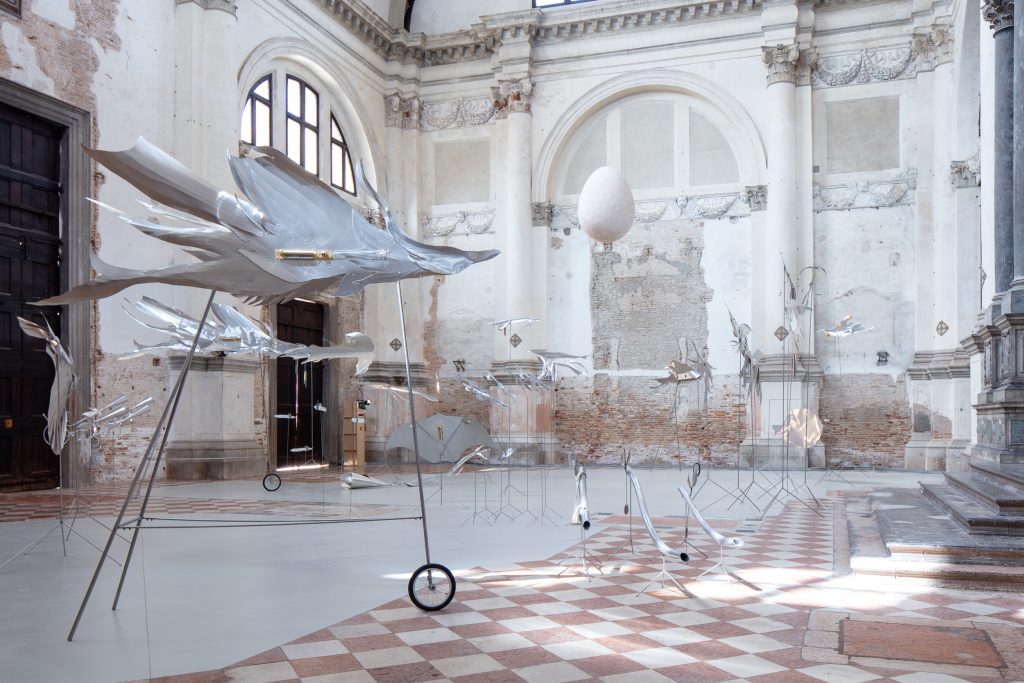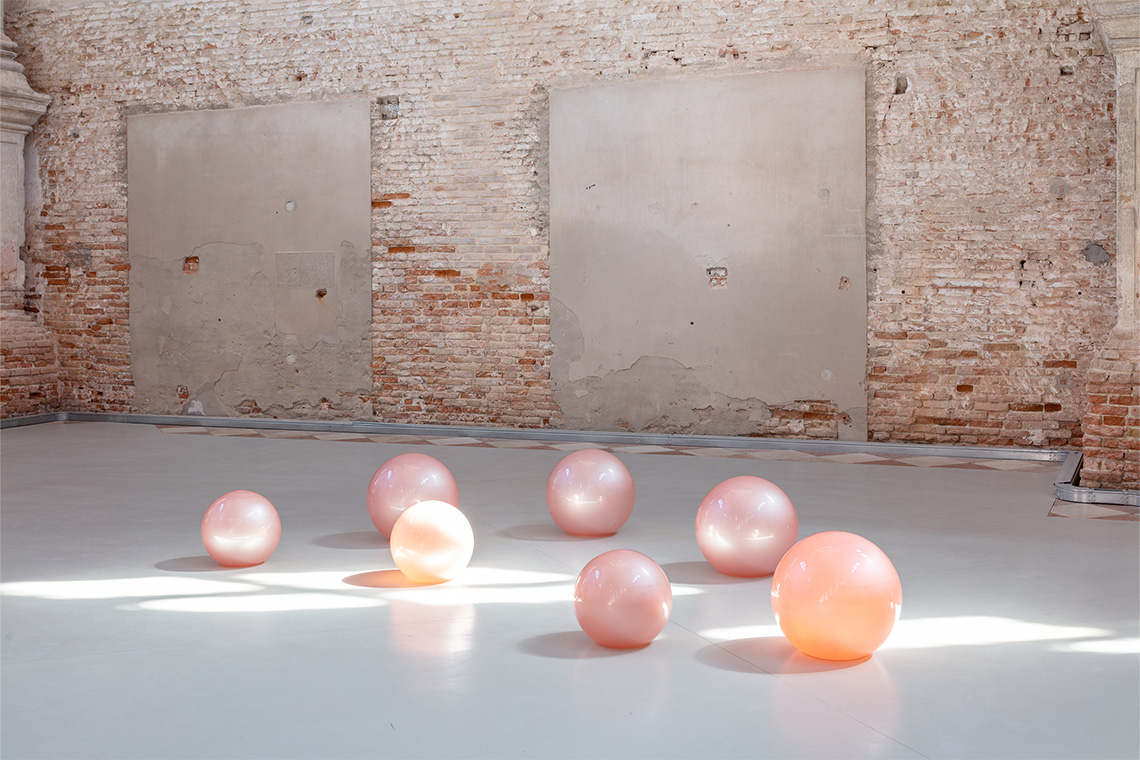At the former Church of San Lorenzo in Venice – now home to TBA21–Academy’s Ocean Space – two site-specific installations present new commissions by Lebanese-American artist Simone Fattal and Berlin-based duo Petrit Halilaj and Álvaro Urbano.
Titled Thus Waves Come in Pairs and curated by Barbara Casavecchia, Ocean Space’s current exhibition takes its name from Etel Adnan’s poem Sea and Fog. The poem refers to the necessity of thinking in plurality – the key inspiration of the third edition of the curatorial fellowship programme The Current (2021–23), led by Casavecchia and focused on the Mediterranean.
The show, which opened in April, is the culmination of the programme and puts into dialogue themes of the past verses the future, climate change, myths and colonialism. “It was this idea of never doing things alone and being in the habit of thinking through multiplicity,” Casavecchia explains. “The artworks tell stories that lead us to imagine futures in which our understanding of the world is transformed by our encounters with other species. One big lesson that one learns from the Mediterranean is that climate is a narrative and also how the entire geography – which then also becomes a geopolitical geography – is shifting super quickly.”
The church itself, divided between two wings with an ornate Baroque altar in the middle, places the two shows together but apart, contrasting and complementing each other.
Fattal’s side is rooted in history, ancient fables and the very beginnings of Mediterranean trade in her installation Sempre il mare, uomo libero, amerai! (Free man, you’ll love the ocean endlessly!), titled after a verse from Charles Baudelaire’s poem L’homme et la mer, which describes the sea as a mirror for the soul.
Several artworks comprise the installation, starting with two sculptures in the empty niches of the marble altar. Against a mirror is written an inscription found in the Temple of Apollo at Delphi: “Know Thyself”. In the other niche stands Young Boy, a clay figure meant to evoke hope, new life and youth.

“I wanted to link the history of the Mediterranean with the Middle East. The Mediterranean brought to Europe everything from spices and glass to fabrics and carpets, which people in Europe conveniently forget,” Fattal tells Canvas. “If you look at paintings depicting the kings and queens of the West, they had exotic furniture, silk, brocade and carpets. All that came from the Orient, through the Mediterranean. The Arabs were the gateway to it and, when they didn’t let the West go through, Europe became obsessed with finding a route to India around Africa.”
To emphasise this, Fattal uses the fable of Ghaylán and Máyya, creating two vaguely human-like figures from clay – one with a dragonfly perched on the shoulder – representing the revolution of global sea trade. A sea of golden glass tiles both separates and connects the figures. Her use of glass in the installation is an ode to the glassblowing traditions of the Middle East, which Venice later become known for, despite its Arab origins.
“Ghaylán and Máyya both had a fleet of boats which traded pearls, but her boats were much faster than his, so he was angry,” Fattal recounts. “He saw that a little dragonfly had landed on his shoulder and was inspired by its wings. He copied the wings and put sails on his boats, so the boats started going faster and that was the birth of trade as we know it.”
Moving further along the timeline to around the 14th century, when sea trade was firmly established and Mediterranean life held a cohesive identity, a series of large pink Murano glass pearls are inscribed in Sabir, an archaic lingua franca spoken across the Mediterranean.
“I created these pearls out of glass because I wanted to link the Mediterranean and the Arabian Gulf,” Fattal explains. “On these pearls I wrote texts in Sabir, which was a combination of Arabic, French, Italian and Spanish and something that all merchants, pirates and slavers knew.”
The work reproduces the text of Sabir’s earliest attested example, the Contrasto della Zerbitana (The Conflict with the Woman of Djerba), an anonymous 14th century poem that recounts an argument taking place on the island of Djerba, off the coast of Tunisia, between a sailor and the mother of a woman he has abused. The piece highlights an era of colonialism often overlooked or forgotten entirely due to the more recent episodes of colonialism during the 18th and 19th centuries.
The installation ends with Bricola, a large earthenware sculpture inspired by the iconic Venetian wooden three-poled navigation markers that guide boats through the lagoon’s ecosystem, evoking the art of navigating the waterways of a more modern era.

On the other side of the church is Halilaj and Urbano’s Lunar Ensemble for Uprising Seas. The installation is fantastical and whimsical, creating an ecosystem of metal sea, land and aerial creatures, with music boxes attached, as a comment on climate change. It is inspired by a Spanish folk song titled Ay mi pescadito, once sung to Urbano by his grandmother and in which young fish go to school at the bottom of the sea to study forms of survival and belonging.
“All of these creatures are also musical instruments. There are music boxes, but also trumpets, percussion and a horn, activated by musicians and players,” Casavecchia explains. “Once a month, in accordance with the cycles of the moon, a performance will appear in the form of a small concert by seven musicians using seven sculptures, making a small parade around the courtyard outside and then coming into the church to continue the music.”
The sculptures are not modelled on real animals, but comprise imagined new species of marine, terrestrial and flying creatures that have evolved to survive the drastic climate changes of our planet. When humans interact with the sculptures, the music boxes are activated. Only by working in harmony as a group will they produce the complete melody. Above the creatures, a large egg-shaped moon hangs from the ceiling, evoking new life and transformation.
Thus Waves Come in Pairs runs until 5 November 2023



